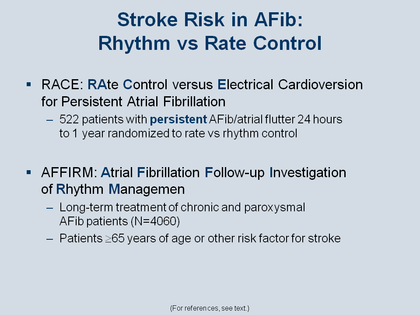Steven A. Rothman, MD - AFib Treatment: General Population - Figure 12
Stroke Risk in AF
A number of well-known studies have looked at rhythm versus rate control and their outcomes.[59] [60] [61] [62] Two of the larger of these studies included
- RACE,[59] which enrolled 500 patients with recurrent persistent AFib and randomized them to treatment aimed at rate control (oral anticoagulants and rate-slowing medication) or rhythm control (serial cardioversions, antiarrhythmic drugs, and oral anticoagulants).
- AFFIRM,[60] the largest AFib therapy trial, which enrolled 4000 patients with chronic and paroxysmal AFib and randomized them to either a rhythm or rate control strategy.
Two further trials included STAF and PAIF. In these trials the patients were generally >65 years of age or had other risk factors for stroke.
Rothman SA. Am J Med 2013; 126: 00-00.
[AFFIRM = Atrial Fibrillation Follow-up Investigation of Rhythm Management; PIAF = Pharmacological Intervention in Atrial Fibrillation; RACE= Rate Control versus Electrical Cardioversion for Persistent Atrial Fibrillation; STAF = Strategies of Treatment of Atrial Fibrillation]

